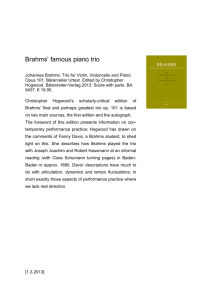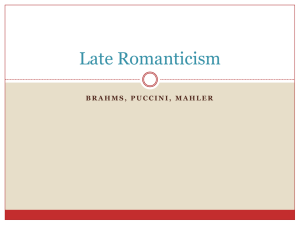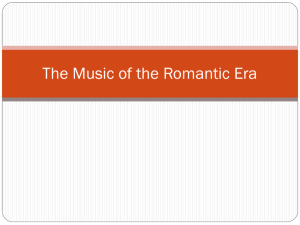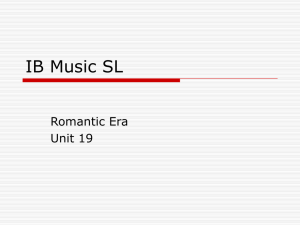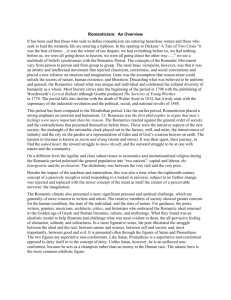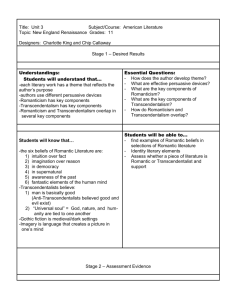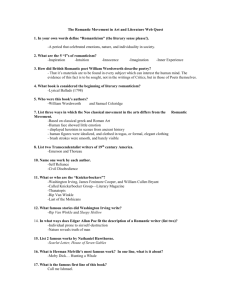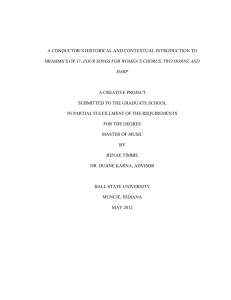20.1
advertisement
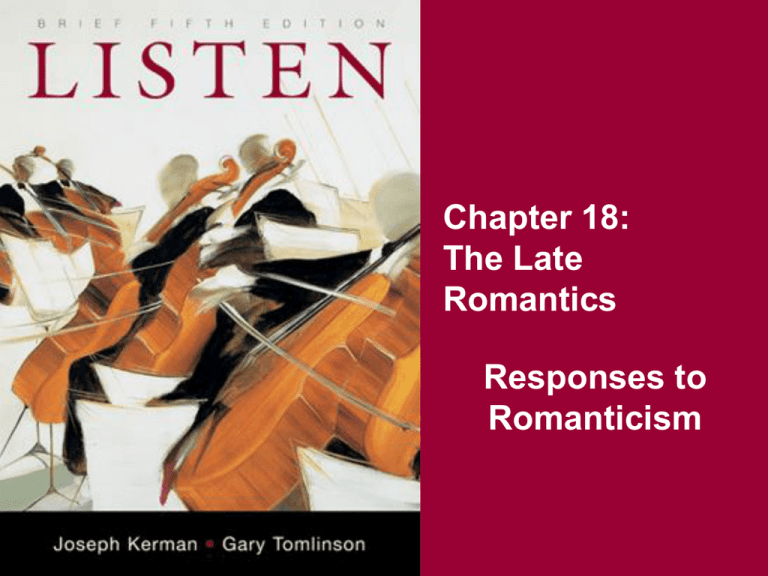
Chapter 18: The Late Romantics Responses to Romanticism Key Terms Classicism Double stops Cross-rhythms Romantic nostalgia Parody Round Responses to Romanticism After 1850, music continued to develop along Romantic lines • Seemed increasingly out of place in a world devoted to industrialization & commerce • Music became an emotional fantasy-world for a society that suppressed feelings in real life Composers responded in different ways • Brahms used Classical models to temper Romanticism’s unbridled emotionalism • Mahler’s music laments Romanticism’s loss of innocence & credibility The Renewal of Classicism: Brahms Rejected many early Romantic innovations • Went back to Classical genres & forms • Wrote string quartets & other chamber works, symphonies, and concertos • Found new life in Classical forms – sonata form, theme & variations, rondo Beethoven’s music was a lifelong model • Brahms was inspired by his nobility & power • Brahms tried to temper the richness & variety of Romantic emotion with Classicism’s strength & poise Johannes Brahms (1833-1897) Son of a bassist in Hamburg Started musical studies at age 7 • Later played piano in taverns & wrote tunes Met Robert & Clara Schumann at age 20 • They befriended & encouraged Brahms Part of Brahms-Wagner controversy • Signed manifesto against Wagner’s music Uneventful bachelor existence in Vienna • Steadily wrote symphonies, concertos, piano works, chamber music, German Requiem, etc. Brahms, Violin Concerto in D Concertos written to show off virtuosos • Often the composer – e.g. Mozart or Chopin • Brahms wrote this one for Joseph Joachim • Joachim helped out, even wrote 1st movement cadenza Brahms uses Classical movement plan • Three movements, fast-slow-fast • 1st movement double-exposition sonata form • Last movement rondo form, the most common Classical concerto ending Brahms, Violin Concerto, III (1) Rondo theme has a spirited gypsy-like lilt • Exoticism – gypsy fiddling popular in Vienna • Double-stops add to virtuoso fiddling effect • Cross-rhythms at the end disrupt meter Brahms, Violin Concerto, III (2) Episodes provide various contrasts • Romantic sweep in B • Lyrical tune in C • Short cadenzas feature soloist Brahms, Violin Concerto, III (3) Thematic transformation in coda • Swinging march version of rondo theme (over a drum beat) in very fast compound meter Romantic Nostalgia: Mahler Embraced Romanticism’s excesses • Wrote huge program symphonies, some with solo singers and choruses • Often attempted to express profound spiritual or metaphysical messages • He once said a symphony is “an entire world” But he could not fully enter this Romantic fantasy world • He pits lost innocence against cynical realism • Music feels uneasy, exaggerated, distorted Gustav Mahler (1860-1911) Born & raised in a dysfunctional family Musical training at Vienna Conservatory Pursued rising career as a conductor • Led many of the finest orchestras of his day • Ten years at Vienna Opera – but anti-Semitism made for a stormy tenure there • Ended career with Metropolitan Opera & New York Philharmonic Could only compose during the summer • Wrote 10 long symphonies & 6 song cycles Mahler, Symphony No. 1 At first a one-movement symphonic poem • Grew into a five-movement symphony • Finally revised into four movements Includes fragments from his songs • Songs about lost love Originally a program symphony • Hero overcomes distress of lost love Individual style of orchestration • Contrapuntal melodies pass from instrument to instrument in kaleidoscopic fashion Third Movement: Background March inspired by a nursery picture • The Huntsman’s Funeral Procession • Forest animals shed tears as they follow the hearse of a hunter • Full of pomp & ceremony – torches, solemn gowns, a banner, pallbearers, a bell, a choir, & a complement of mourners • Why would animals mourn the death of their tormentor in such a lavish manner? • The painting’s innocuous qualities mask its incongruities Third Movement: Use of “Frère Jacques” Similar incongruities pervade the March • On first hearing the music seems genuinely solemn, mournful, perhaps even tragic • This feeling is completely deflated when you finally recognize the tune – “Frère Jacques”! • Distortions make the tune harder to recognize • Mahler casts the tune in minor mode, slows down the tempo, & alters a few notes • Tune introduced by the last instrument you would expect – a bass playing in high register • Vulgar dance band phrases also deflate mood Third Movement: Funeral March (1) Very free march-trio-march form Ironic funeral march & personal lament • March theme a distorted minor-key parody of children’s round “Frère Jacques” • Trio taken from a Mahler song about lost love March theme treated as a round • Over mournful, monotonous drumbeat Third Movement: Funeral March (2) Section 2 present dance-band fragments • Exaggerated, parodistic, even vulgar phrases • Return to funeral-march motives at the end Third Movement: Funeral March (3) Trio offers a complete contrast • • • • Begins with warm major-mode sounds Trio’s theme is a delicate, lyrical melody Tune from a nostalgic song about lost love Its innocent quality soon turns bittersweet Third Movement: Funeral March (4) March returns in final section • Faster tempo with new counterpoints • Dance-band phrases interrupt at even faster tempo for a wild moment of near chaos • Return of funeral-march motives that ended Section 2 – the music dies away
